#TBT A Vintage Seiko Buyer’s Guide to Affordable Goodness
Here it is, our updated Vintage Seiko Buyer’s Guide. The thought of pulling together a directional like this sounds audacious, but as you’ll see, Seiko makes, and made, a lot of things relatively easy for us. But…as with all things in life, there are caveats. This guide won’t focus on all Seiko through the years, but we’ll focus largely on watches from the mid-1960’s through the mid-1970’s and pictorially, I’ll feature some seldom seen watches to whet your appetite.
Vintage Seiko Buyer’s Guide
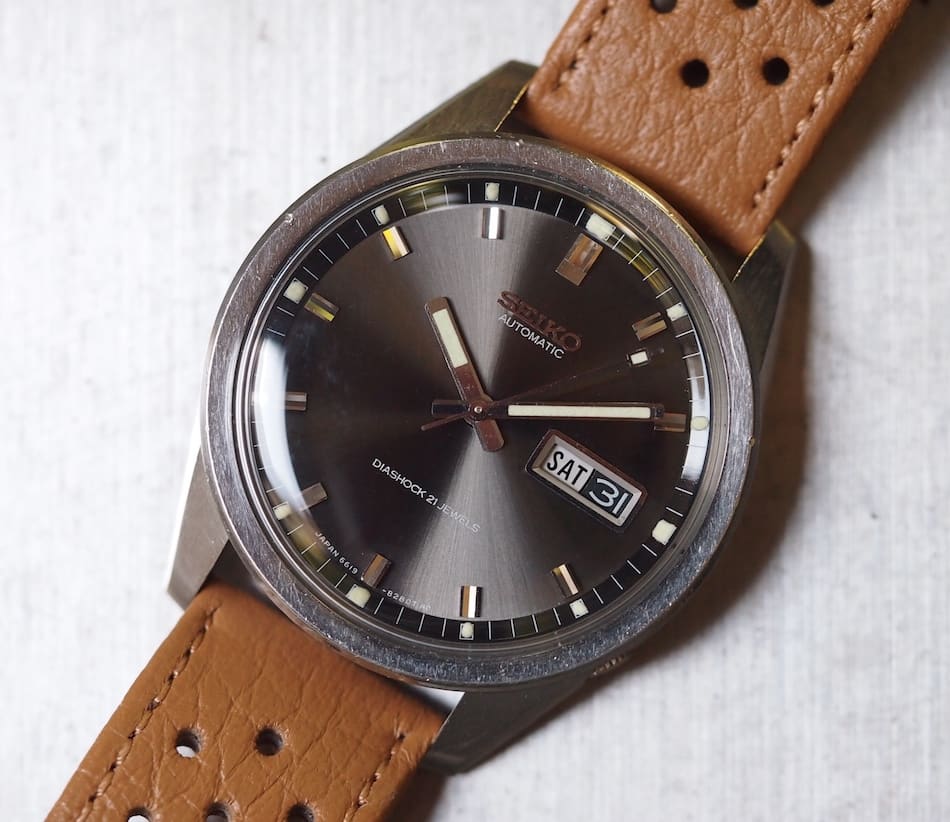
This Seiko 6619-8230 is a masterpiece…large and beautifully designed!
Here on Fratello, we ran an in-depth article on Seiko’s vintage Sport Divers and this made a lot of sense because the watches are truly sporty, contain rotating bezels and other things that collectors desire. We’ve also talked about older (or vintage-inspired) Grand Seiko and King Seiko. That being said, we’ve left out a major portion of the vintage Seiko catalog during our journeys and this sub-genre is none other than the “regular” collection. I’ve chosen to use some of these models (yes, I threw in a few sport divers with rotating bezels that I’ve recently restored or that are on their way into the spa) that I’ve picked up over the years as the focal point for illustrating our Vintage Seiko Buyer’s Guide because so many are anything but regular.
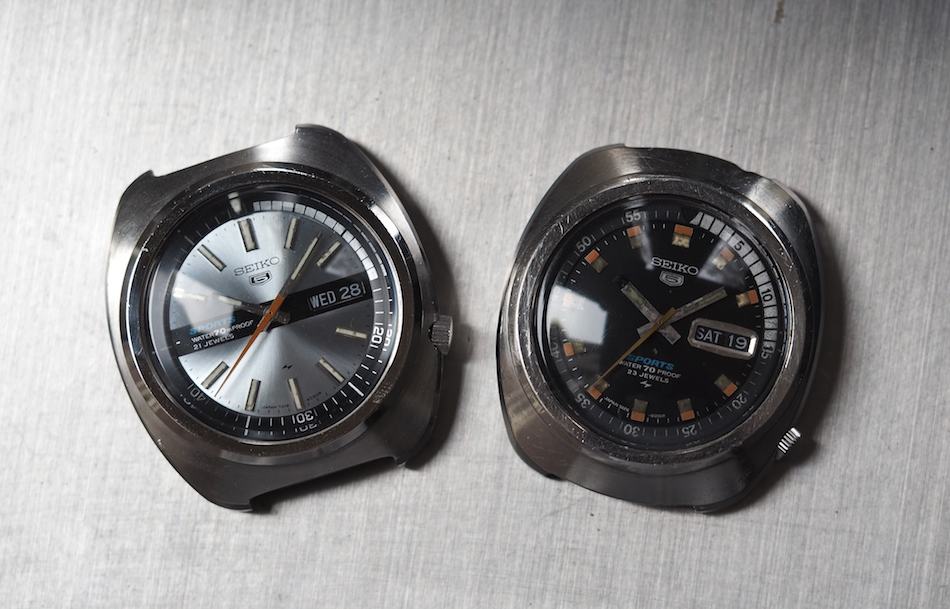
A pair of “Daini” vintage sport divers rescued and restored – a 7019-6030 on the left and a 5126 model on the right.
Seriously Cool Watches
Before we get into the heart of the Vintage Seiko Buyer’s Guide, I’d like to detour a bit and opine on why some of the normal Seiko’s are so darn cool and worth your time. If you’ll indulge me, I’d also like to explain how and why I began collecting them.
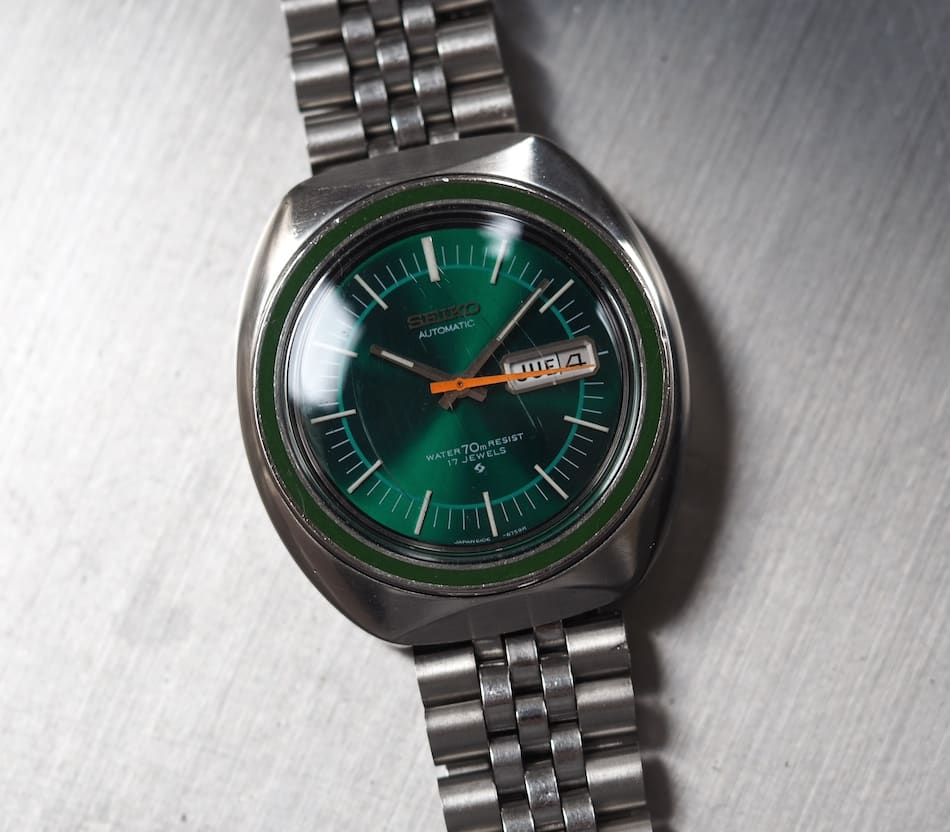
Here’s a Seiko 6106-8569 with a brilliant green dial – note the crazing of the acrylic crystal.
You see, when it came to the 1960’s and 70’s, whether watches came from Switzerland or Japan, there were bucket loads of forgettable blasé dress watches. I quietly refer to these as “Poindexter” watches because they remind me of watches that a typical office worker would wear back in the day with a polyester short-sleeve dress shirt, pocket protector, and glasses. Hey, I’m sure people will chuckle at us one day for the way we dress today, but my point is that the style for most everyday things seemed pretty utile and downright boring. Legible? Hell yes! But they’re absolutely mundane and places like eBay are littered with these watches from some really great names like Omega, Longines, Tissot, Seiko and others. Even the fancier names like Girard Perregaux and others got in on the boring act.
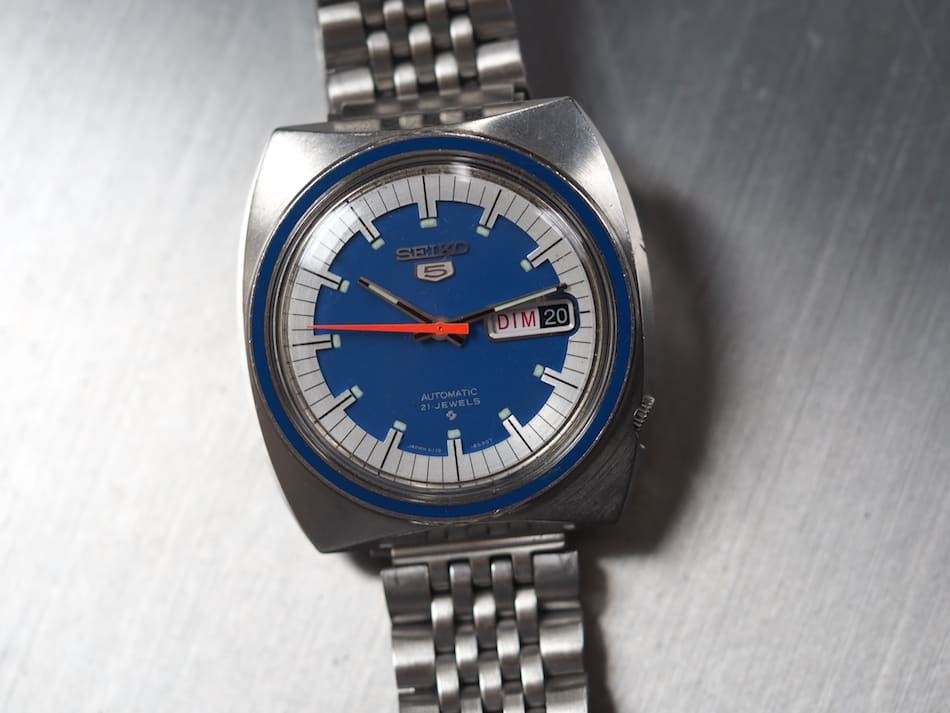
This Seiko 6119-8490 has one of the coolest vintage Seiko dials I’ve ever seen. Note the applied “Seiko” and “5” logo along with the white inner bezel and blue outer ring. Magnificent!
But one thing I’ve consistently found with Seiko is that they made some seriously cool “regular” watches, alongside their blah lineup, that straddled the line between sport and dress – and also added that one thing that was often so lacking during this period: color.
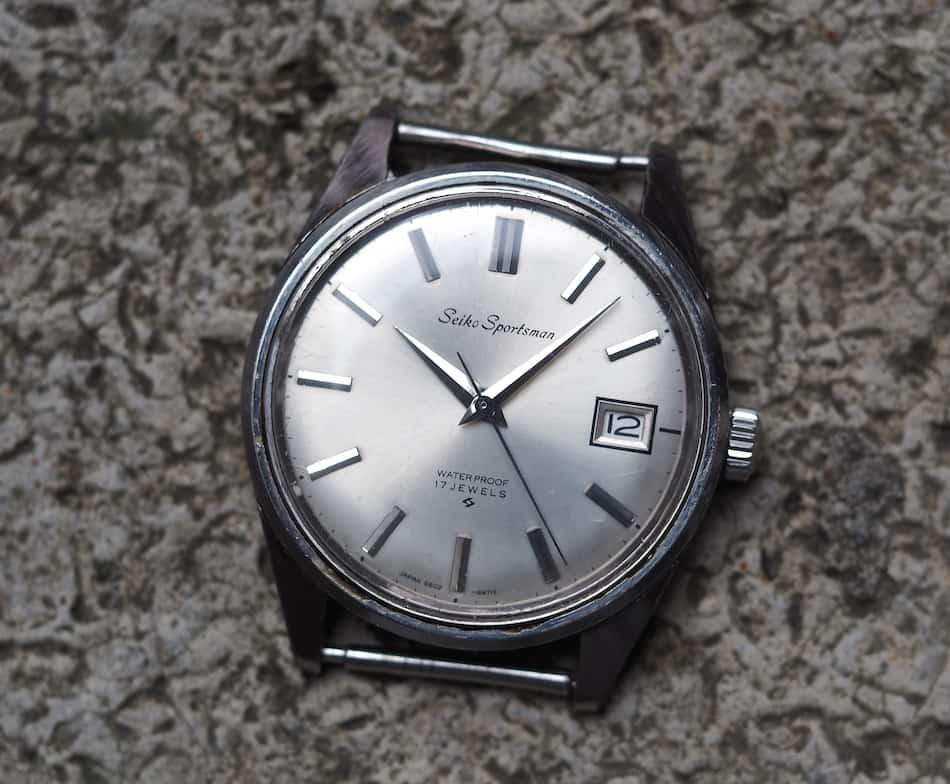
The large-cased manual wind Seiko 6602-9981 that cost $25 – it looks fantatsic on a bright NATO.
This Vintage Seiko Buyer’s Guide Focuses on the Affordable
Also, as more background before jumping into the Vintage Seiko Buyer’s Guide, why did I buy these not so sporty/not so dressy watches? Well, I bought them for the same reasons that I’ve bought scads of other Seiko’s plus an added bonus: these watches are dirt cheap. The basic reasons for buying any vintage Seiko are simple. First, I’m fairly convinced that you actually have to work to kill off a Seiko.
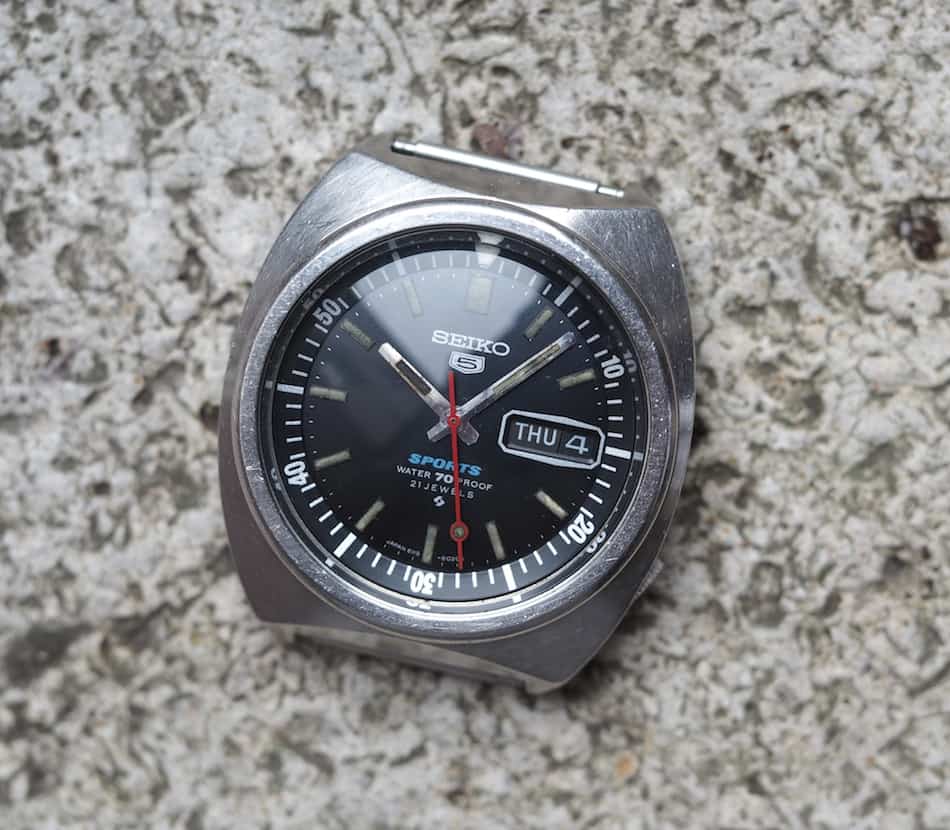
One of the more common and affordable Seiko Sport Divers is this 6119-6023.
As my buddy Andreas likes to say, old Seikos are like Toyotas (same country, by the way) because they simply don’t die and they’re easy to fix. Second, and we’ve said this so many times, but it’s worth repeating because these are cheap watches – Seiko’s quality was simply ridiculous. These watches were built with robotic efficiency – which is admittedly pretty non-sexy compared to the thought of someone toiling away in the hills of Switzerland – but it has left us with some amazingly well-preserved pieces today. Adding to that, the movements are bulletproof, many have never been restored or viewed, and still run amazingly well. Design wise, I ask you to take a look at the details: the hour markers, the case finishing, the dials and more because there’s usually more than meets the eye. Finally, as I’ve mentioned, these Seiko’s are cheap. I paid between $25 (yes, really) and $125 for everything that you’ll see here and in rare cases, I put another $70-80 of service on top. In a vintage watch world gone crazy and in a new watch world filled with loads of $250-300 faux-vintage pretenders (they’re fashion watches, let’s be honest), these Seiko’s just kill it with value.
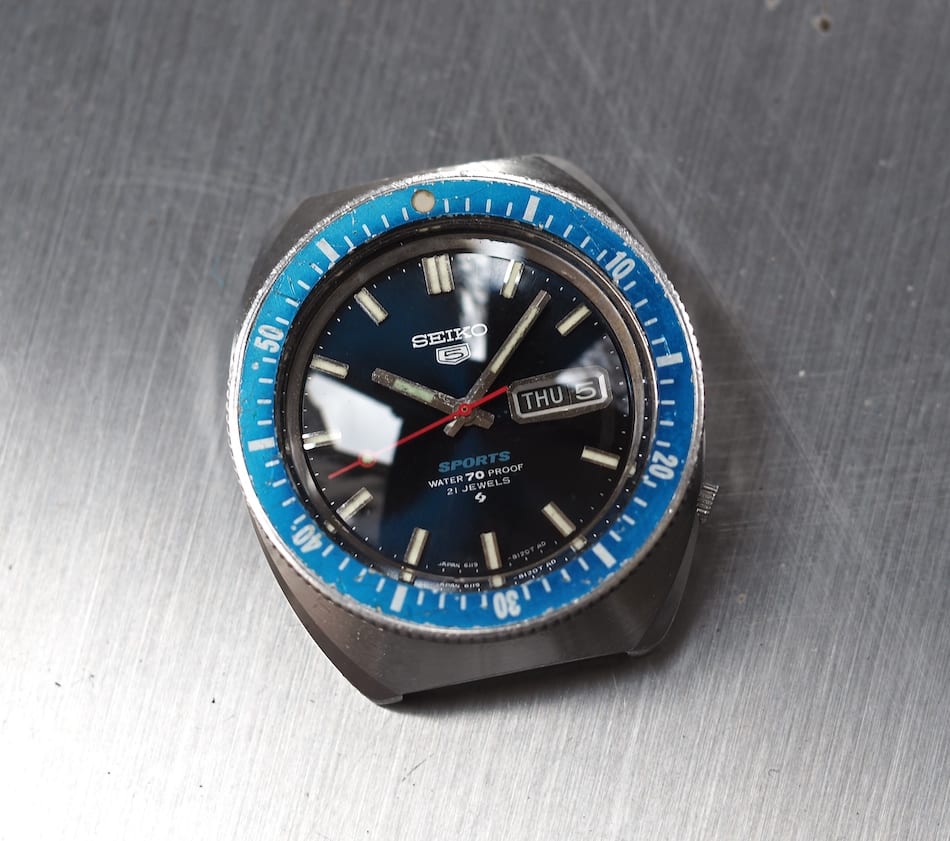
One of the most common vintage Seiko movements, the 6119, is showcased within this gorgeous Sport Diver, the 8120.
A Guide to the Guide
Now for some explanation on how to use this Vintage Seiko Buyer’s Guide. From a movement perspective, I’ll discuss some of the key engines used in three-hand watches – these were used in sports watches, dress watches and everything in between. When we talk about how to “date” a vintage Seiko, finding crystals, and other things, the guide works across all types of Seiko’s. Whatever we discuss, if there topics that only refer to certain types of Seiko’s, I’ll do my best to make a note of it. Finally, as I mentioned above, exceptions exist – so, when buying, ask within your favorite Seiko forum such as the SCWF or Wristsushi if you’re unsure!
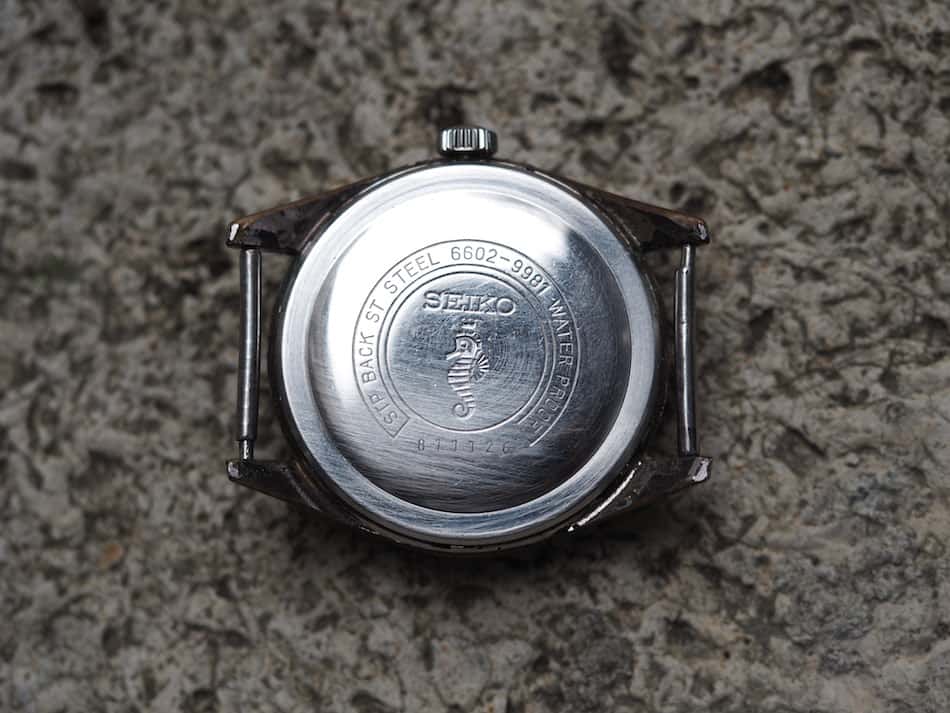
A snap back on a manual wind Seiko 6602-9981 from January, 1968.
Understanding Vintage Seiko Nomenclature
I think it’s appropriate to kick off our Vintage Seiko Buyer’s Guide with a lesson on naming convention. When we talk nomenclature, most (but definitely not all as we see on some manual wind pieces) Seiko’s carry a name using the format of “xxxx-yyyy” where both the “x’s” and “y’s” are numbers. The “x’s” in this case designate a movement reference. This is important because when looking for vintage models, a given movement often spans the gamut of dress to serious dive watch and only the power plant inside is the same. Also, if you’re interested in a given model, when you begin to research specifics, you may even find that a movement – I’m thinking of the ever popular 6106 automatic – began its production without hacking or even with a quickset date but not day and then transitioned a year or two later. Some popular references that present opportunities are the 5126, 6106, 6119, 6619, and 7019 but this is by no means an exhaustive list. When sifting through eBay, you’ll see other popular number searches once you try one of the references above, so my advice is to get lost down the rabbit hole and enjoy the ride – the myriad number of variations will blow you away. Also, as a little check, look on the dial below 6:00 and you’ll find the movement number noted there as well.
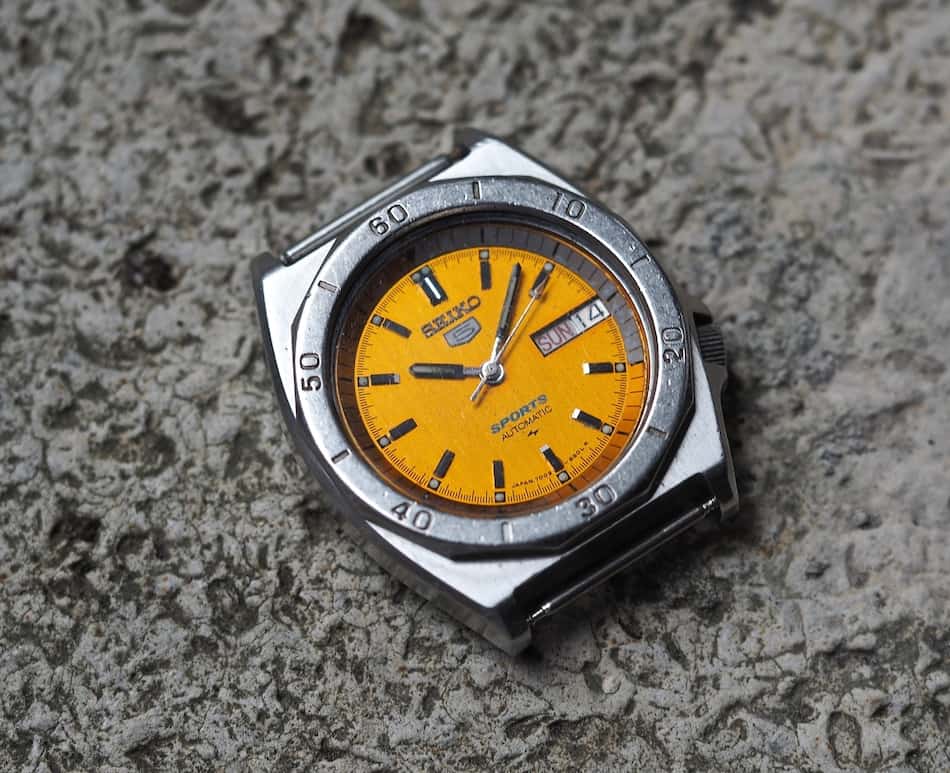
The Seiko 5126-8100 from 1979 “just” qualifies as vintage and note that it still carries the Daini symbol on the dial.
When it comes to the model number, or “yyyy”, portion of the name, this is where the individual design is defined. Seiko was a touch tricky with this because there are sometimes multiple 4-digit codes that reference similar or same models. It’s ok as Seiko often did this to designate models for different markets (ex: Japan versus rest of world). If you have doubts, and this is a good rule of thumb for any Seiko, go to Google images and type in the full name of the watch (all 8 digits) and ensure that the watch you desire has the right case back. Case backs are interchangeable, so ensuring the right case back is with the right watch is key!
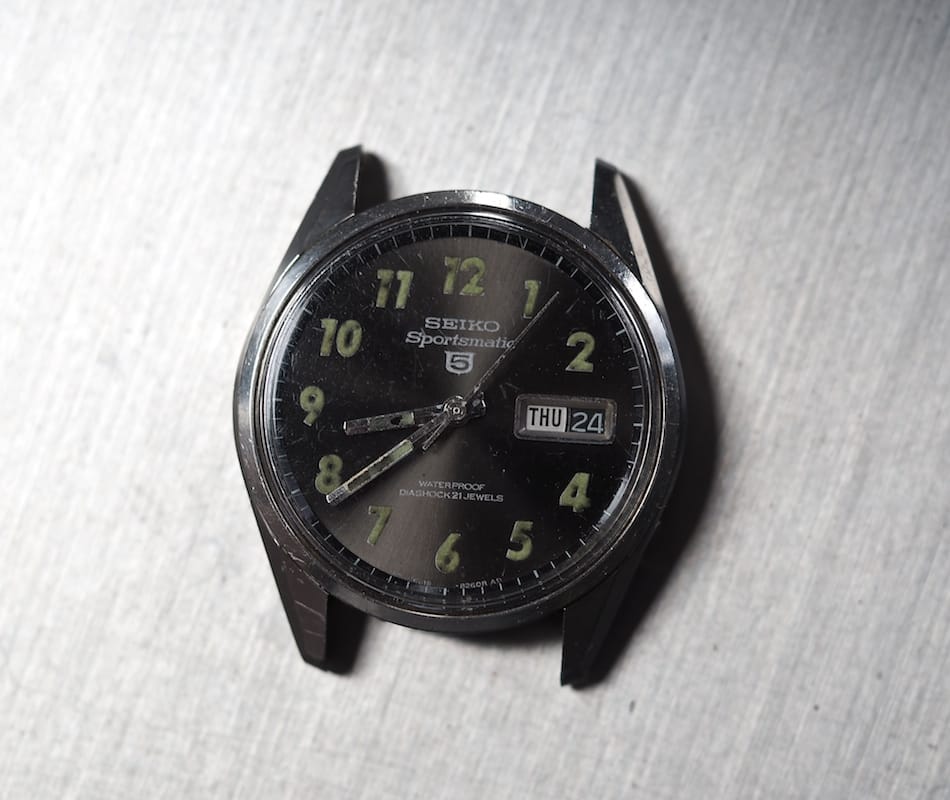
This rough and tumble Seiko 6619-8060 from March, 1967 will look great after a service, new crystal and a hand relume. These Arabic-dialed ipeces are desirable, yet affordable, as they were popular with soldiers in Vietnam. Note the hidden crown.
Crowns…a Purposeful Afterthought
Let’s talk crowns for our Vintage Seiko Buyer’s guide. The positive for originality sticklers on this front is that Seiko didn’t sign them. On the other hand, Seiko crowns are specific. They often either were concave-inward or contained a smooth surface that appears as a “cap” above the ridges. For the watches we’re discussing today, none are screw-down and many are impossibly small. Why are they so small? I’ve mentioned this before, but it’s worth repeating: Seiko was very proud of its “magic lever system”. This system allowed for the rotor to wind the mainspring when spinning in either direction and, therefore, Seiko was of the opinion that the user should “set it and forget it”. Going one step further, none of the vintage Seiko automatics can be hand wound – so the crown is not an oft-used control.
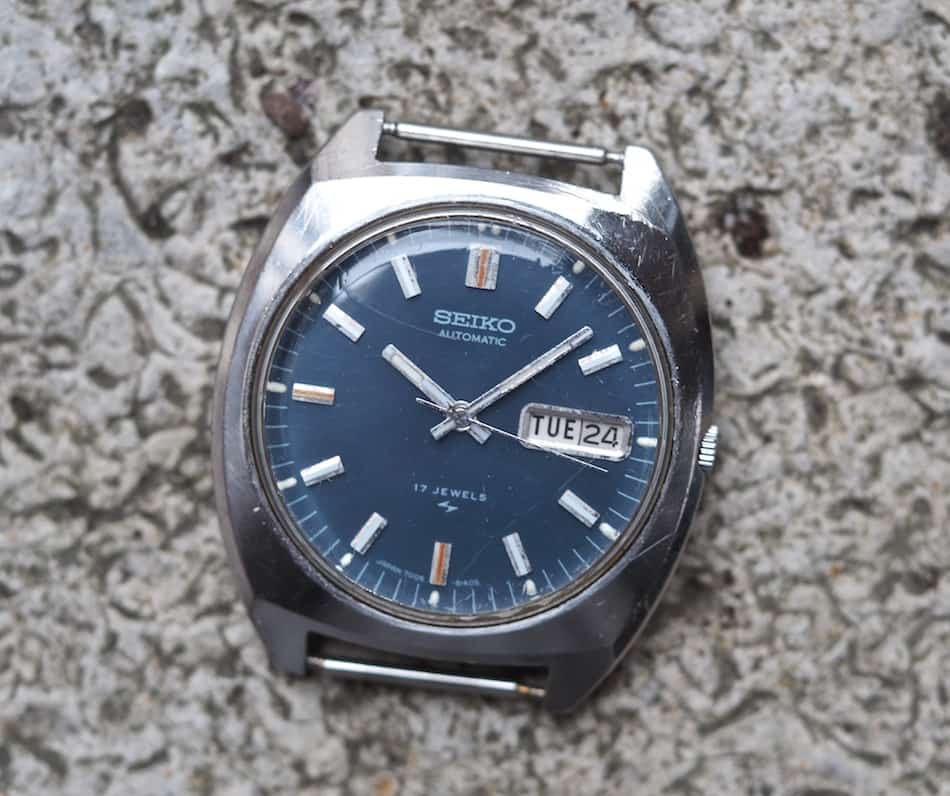
A 7006-8059 purchased for about $45. Sure, it needs a crystal, but it runs perfectly.
Acrylic or Hardlex, it’s Crystal Clear
Crystal-wise, vintage Seiko’s came with either Seiko’s own Hardlex mineral glass or acrylic. Finding out the model number – as beat up and unsalvageable crystals are very much normal when locating good deals – is a breeze with this site. Simply enter the full model number and you’ll receive the crystal part number. Then, head over to eBay or the for sale board on your favorite Seiko forum and unless it’s something truly odd, you’ll likely find one immediately for about $10. As mentioned, bad crystals are very normal on old Seiko’s as most previous owners never had interest in fixing what was a rather inexpensive watch. But – it’s one of the best tips I can give in this Vintage Seiko Buyer’s Guide; never let a bad crystal stop you from buying an otherwise great watch!
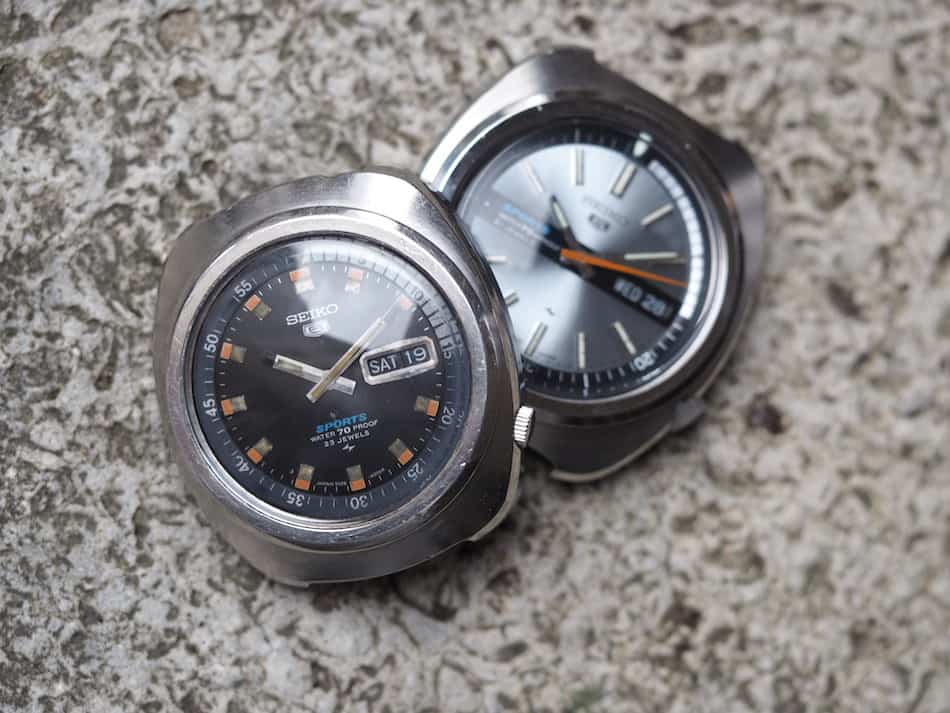
Despite some rough cases and wabi, either of these pieces would look great on a rustic strap or NATO.
“Wabi-Sabi” – a Must in any Vintage Seiko Buyer’s Guide
Time to talk dials and hands… Older Seiko’s are famous for obtaining what collectors note as “wabi-sabi”. In Seiko speak, this usually means patina x 10. These lovely Japanese watches often spent a heck of a lot of time in humid environments weren’t serviced and moisture made its way into the watch. Oddly enough, moisture didn’t stop most old Seiko’s but it did create some odd aging on the lume and hands to the point that some look downright fungal! The wild thing with Seiko’s is that some people love a lot of funk and some don’t. So, if you don’t love it, keep moving, but unless the movement is a rust trap, don’t be surprised if the old beast ticks on reliably after a simple service.
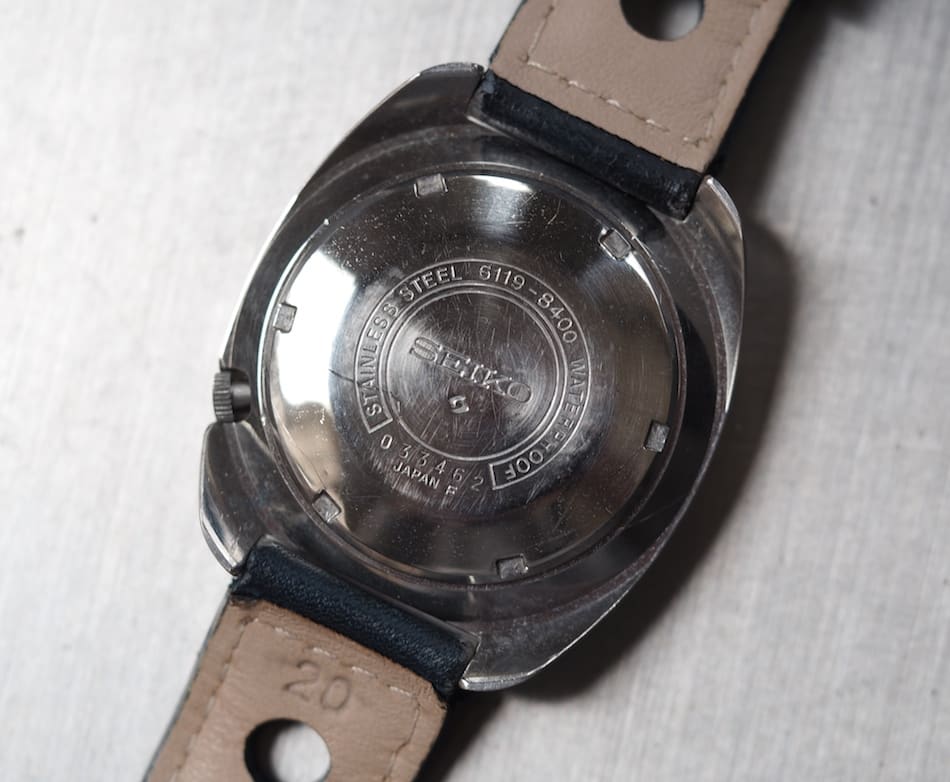
The “Suwa” symbol as seen on the case back of a Seiko 6119-8400 from March, 1970.
Some more tips are in order on the cosmetic side for this Vintage Seiko Buyer’s Guide. It truly pays to do your research when it comes to hands. One of the most common mistakes I see in vintage Seiko are incorrectly replaced hands. Finding correct hands can be a real challenge, so I usually walk away. Oh, one other tip for good measure. See that funky little symbol above 6:00? If it looks like a hash sign that’s tilted 45 degrees, it’s from Seiko’s “Suwa” or “first” factory.
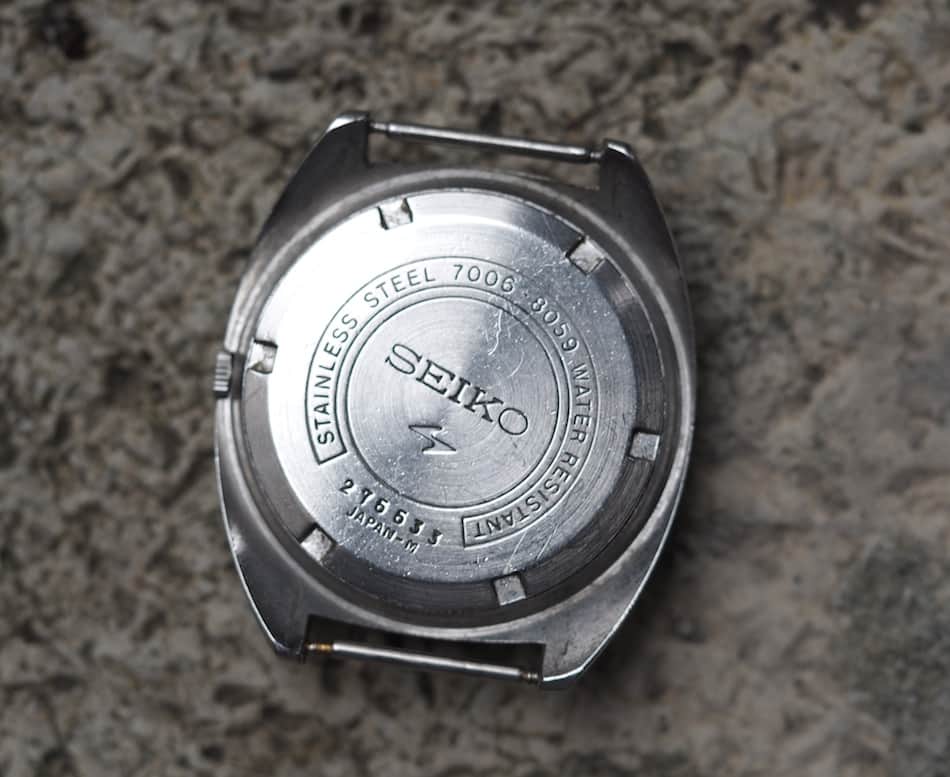
A look at the back of 7006-8059 model from July of 1972. Note the “Daini” factory symbol on the back.
If it looks like a sideways lightning bolt, it’s from the “Daini” or “second” factory. An awesome fact is that these sites both designed and produced unique movements! I’ve noted that Daini pieces are tougher to find and often have a crown at 3:00 instead of the normal 4:00. Also, Daini watches often change date via pulling out and turning the crown whereas Suwa pieces typically allow the change to occur by repeatedly pushing the crown inwards and allowing it to spring back.
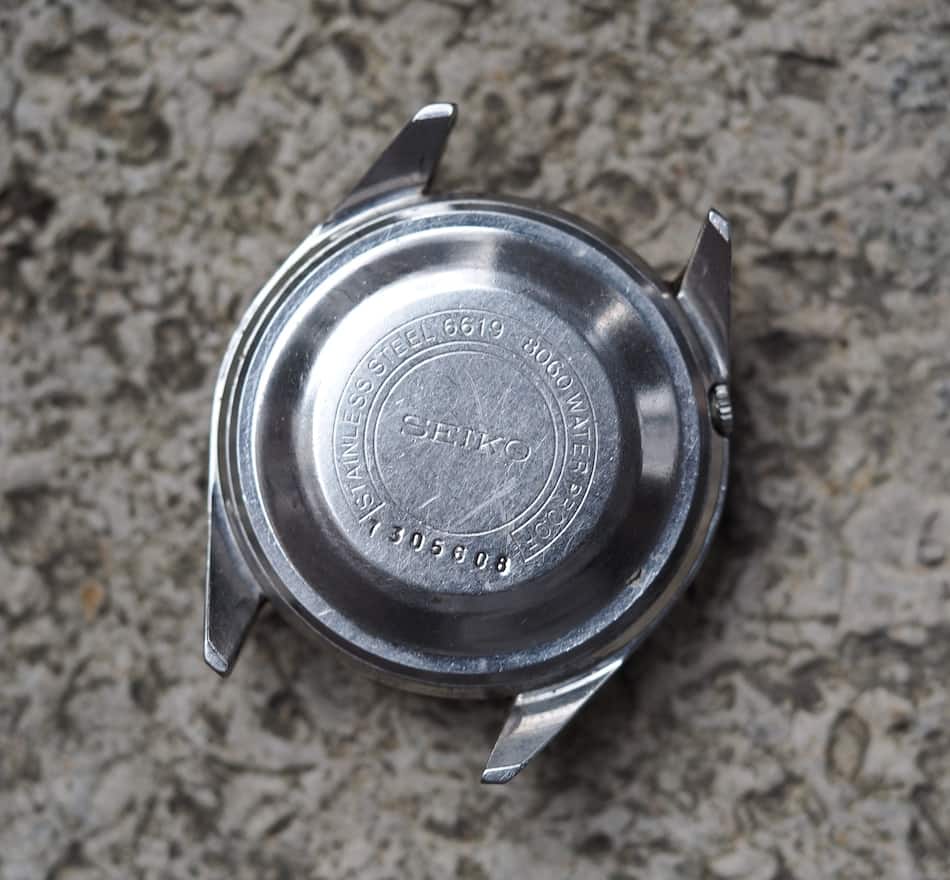
A look at the back of the Seiko Sportsmatic 6619-8060 from March, 1967. As this is an “earlier” vintage piece, it lacks a Suwa or Daini logo on the case back.
Intelligent Numbers – Dating your Seiko
What would the Vintage Seiko Buyer’s Guide be without a tip on dating your new/old watch? Well, here again, Seiko makes things simple. A quick look at the back will yield a serial number that is normally 6 digits. The first digit tells us the year of production and the second number tells us the month. If you know the decade, you’re all set – it’s that easy!
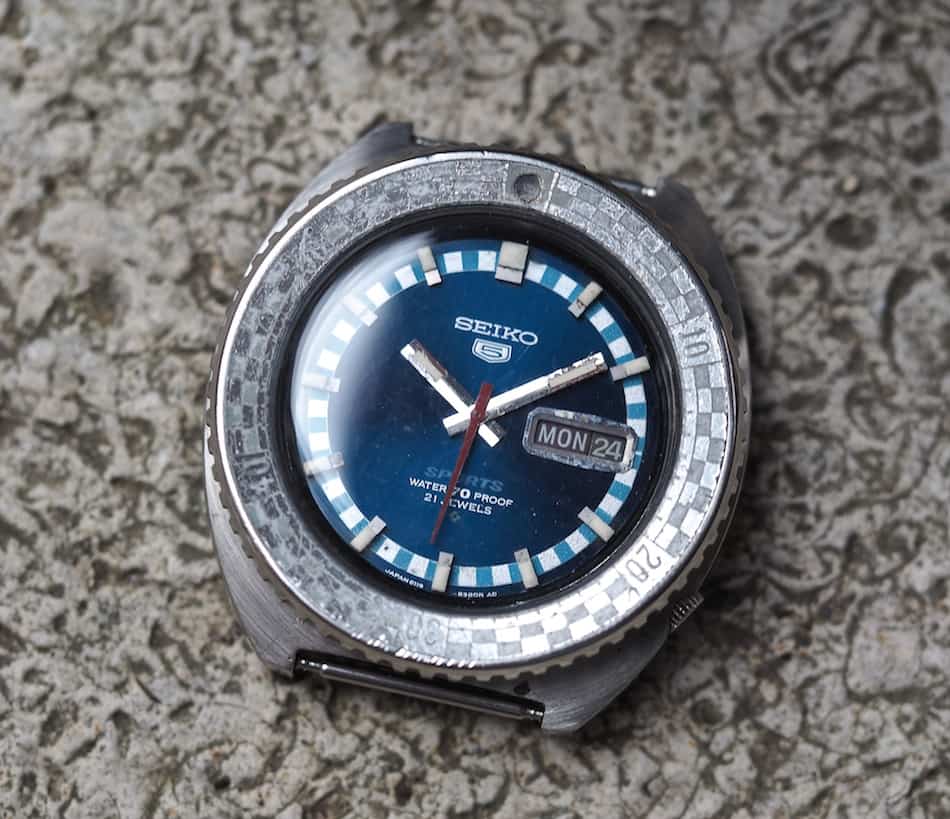
A Seiko 6119-8300 “Rally Diver” in need of a service and crystal. This was a $70 find on a really desirable watch – note the faded but original bezel.
Sometimes it Pays to Scrape the Bottom of the Barrel
Now, I’ll share some subjective advice within this Vintage Seiko Buyer’s Guide on condition and pricing. Consistent with my comment above about crystal condition, I like finding “diamonds in the rough”. I don’t like beat up watches, but it is common to find desirable Seiko’s with loads of wrist DNA and truly awful straps attached to them that often detract from a listing.
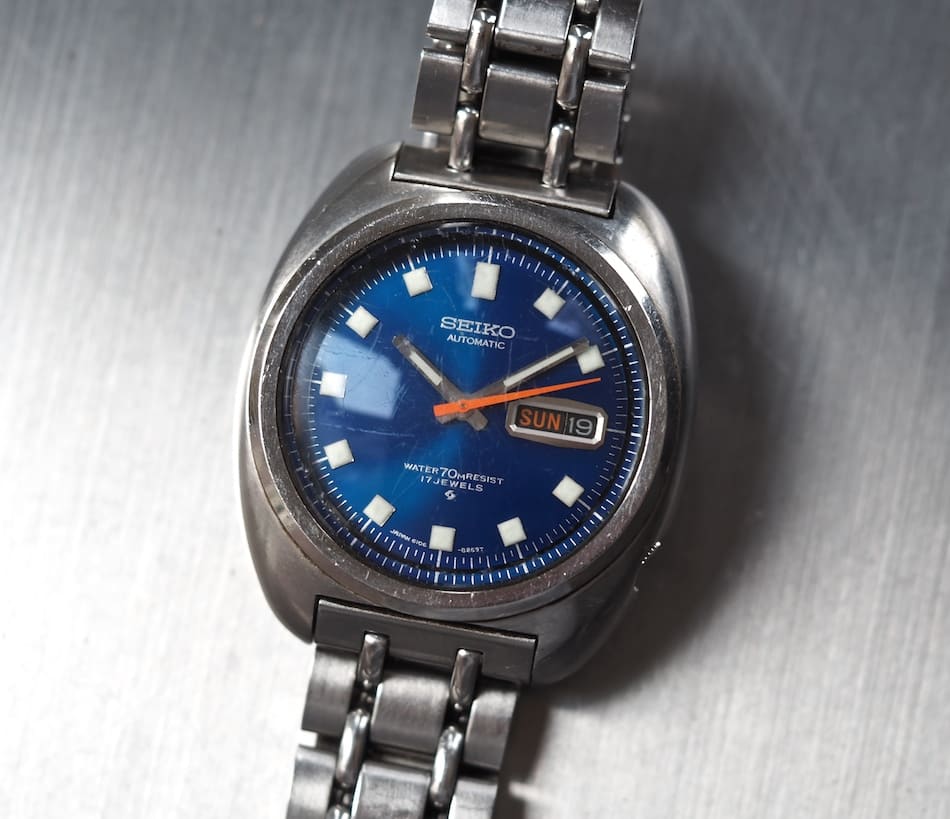
Another very common movement is the bulletproof 6106. Here it is found on the sporty 8237 from the late 60’s/early 70’s. This one has its original bracelet.
On the note of accessories, I rarely care about bracelets and would barely pay more for a supposed original one on a watch because they’re often stretched, flimsy or – strangely – ugly. I also rarely care about whether a 3-handed Seiko is operational because they are all repairable. The only exceptions to the rule are with chronographs (can be fixed, but it adds a measure of difficulty), divers that are missing bezels, or divers where the internal bezels no longer rotate. I also stay away from watches with missing or incorrect hands because life is too short to search and – normally – there are other watches out there to select.
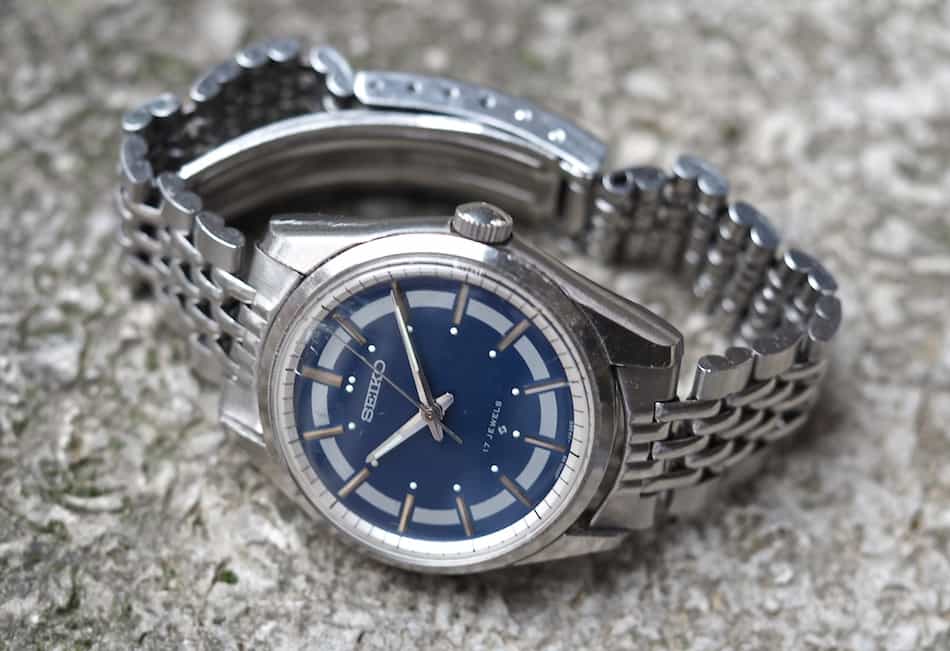
This Seiko 66-7109 with original beads of rice bracelet and manual wind movement isn’t huge but is a “blast from the past” with its production in the mid 1970’s.
Vintage Seiko – a Great Alternative to Faux Retro Watches
When it comes to pricing, I can tell you that I spent no more than $125 for any of these watches. It is funny because you will often see similar models selling for a wide range of prices – it’s just the way that it goes and I often cannot explain it! Coming back to an example on this page, the manual wind Seiko “Sportsman” model does have a chrome case, but it cost a whopping $25, keeps amazing time and is a large watch. Speaking of size, all of these pieces are above 36mm and some command significantly more space on the wrist. To me, that makes them highly wearable as everyday pieces. Plus, note the rich array of colors and one can see how 5-10 of these could easily find their way to your collection.
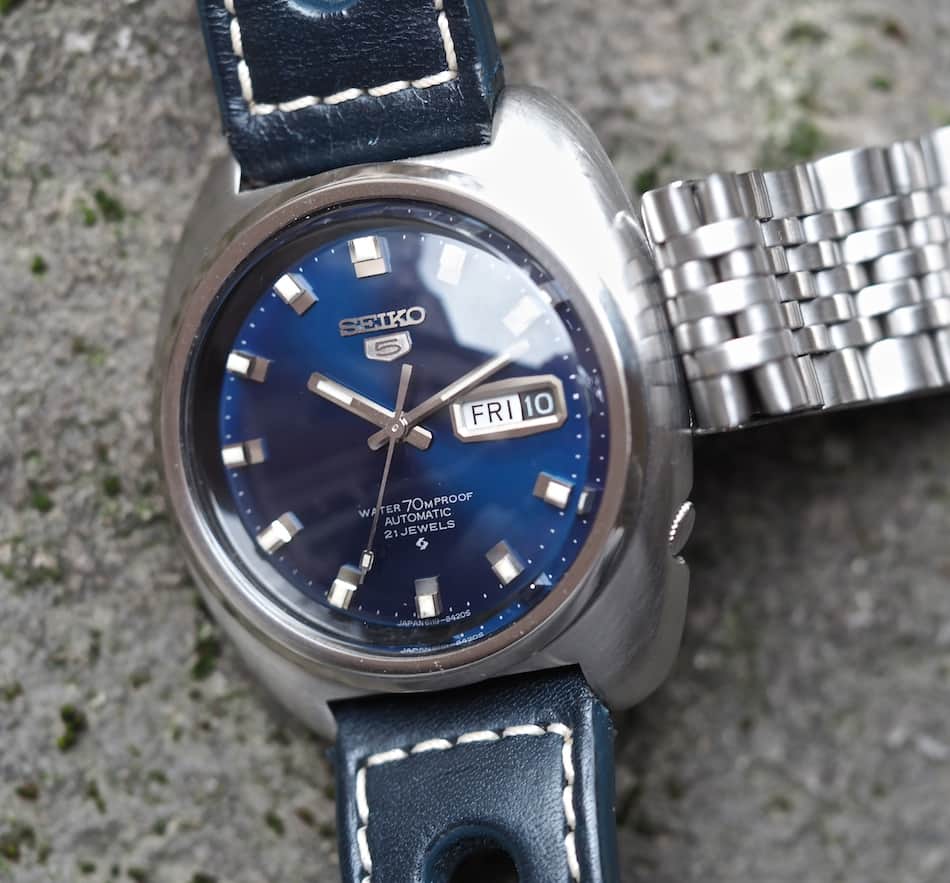
The Seiko 6119-8400 from the front. Just look at that dial and the attention to detail. Try and find something Swiss for $100 that looks like that!
As mentioned, head over to eBay and kill an hour looking at multitudes of vintage Seiko’s. Yes, many will come from the Far East, but the prices often make the risk worthwhile. Many friends of mine are die-hard Swiss watch fans and they quietly refuse to go down the Seiko path. Maybe it’s because these Japanese watches are everywhere – I like to think it’s their fantastic build quality – or because they lack some of the traditional styling found on Swiss watches. I’m not sure of all the reasons, but I do think that if you exclude adding a nice vintage example from one of the world’s most innovative and successful watch companies, you’re missing out on a real opportunity. Plus, they’re often cheap! I hope you enjoyed this “starter” look at a Vintage Seiko Buyers Guide. Feel free to add your tips below or some pics of some of your favorite bargain classic Seiko’s! Enjoy the heck out of your hunt!
*This guide appeared first on November 24, 2016 and has been updated since.


















